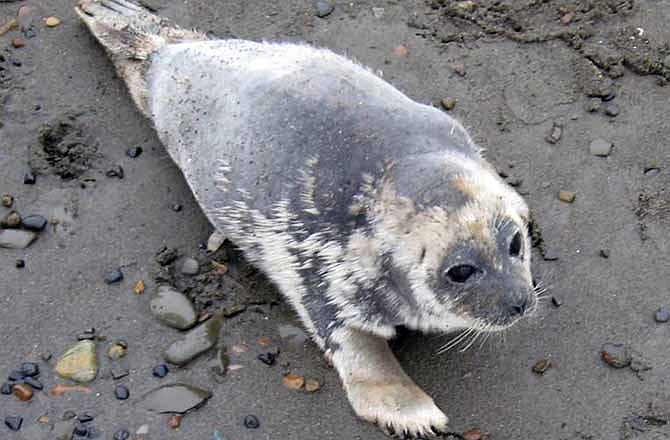ANCHORAGE, Alaska (AP) - An unknown disease is killing or weakening scores of ringed seals along Alaska's north coast, where the animals have been found with lesions on their hind flippers and inside their mouths.
Ringed seals, the main prey of polar bears, and a species that rarely comes ashore, in late July began showing up on the Beaufort Sea coast outside Barrow with the lesions, patchy hair loss and skin irritation around the nose and eyes. The outbreak was reported first in the Alaska Dispatch.
Officials from the National Marine Fisheries Service and the North Slope Borough said Thursday that 107 animals were found stranded from late July through Sept. 29 and 99 appeared to have lesions. Nearly half died.
"Forty-six of the animals were dead when found, or died shortly thereafter," said Julie Speegle, spokeswoman for the National Marine Fisheries Service. Seals still alive were lethargic or showing labored breathing.
Necropsies revealed lesions were not limited to skin of seals. Biologists studying the dead animals found lesions in the respiratory system, liver, lymphoid system, heart and brain, she said.
Wildlife authorities in Canada and Russia have reported similar incidents, she said.
"We don't know if they're related, but they're similar," Speegle said.
Linda Deger, a spokeswoman for Fisheries and Oceans Canada, said by email that ringed seals are the only species reported to be affected and the department and other agencies are investigating.
"At this point, we don't know exactly what is causing it," Speegle said. "Laboratory findings have been inconclusive to date but samples have tested negative for pox virus, herpes virus, papillomavirus, morbillivirus and calicivirus."
It's also not known whether symptoms could be transferred to other animals or humans, she said, although officials are keeping a close watch.
A press release from the North Slope Borough said the strandings included animals as far west as Point Lay and Wainwright on the Chukchi Sea. That outbreak, the borough said, appeared to peak in mid-August. Several dead walruses were examined at Point Lay with skin lesions and hunters reported lesions on two bearded seals, the borough said.
Jason Herreman of the borough's Department of Wildlife Management said villagers have been warned not to eat stricken seals. Most ringed seal hunting by borough communities is done in the spring.
"We've been talking to our hunters since this first came to our attention in July," he said by phone from Barrow. "By that time the majority of seal hunting was done for the year."
The National Oceanic and Atmospheric Administration in December proposed listing ringed seals as a threatened species because of the projected loss of snow cover and sea ice from climate warming. Sea ice and snow are crucial for ringed seal breeding.
Ringed seals are smallest and most numerous ice seals but are one of the hardest to count because they are spread over hundreds of miles of remote ocean. In summer, seals are in dark water. In winter, they're usually under snow or ice.
Brendan Kelly, a long-time ringed seal researcher now working as deputy director of the National Science Foundation's Arctic Sciences Division, said Thursday the unknown disease could be a blip in the population or fairly widespread.

